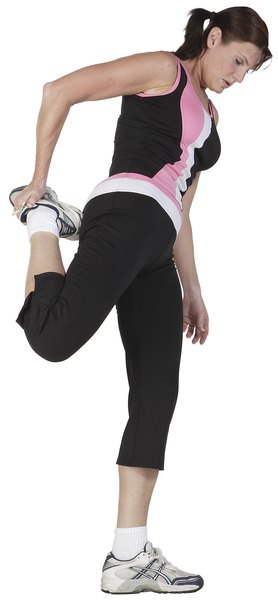A Warm Up for Circuit Training

Circuit training allows you to improve muscular endurance, burn calories and build muscle using a series of timed exercises, or sets of exercises using a fixed number of repetitions, throughout a workout. Starting a circuit-training workout without warming up, or with an incorrect warm-up, can decrease your benefits during the beginning of your routine. If your heart, lungs and other muscles aren't properly warmed up and working together before you start lifting weights or performing vigorous movements, you won't get the most effective muscle contractions possible as you start exercising. A proper warm-up for a circuit-training routine includes a wide range of dynamic stretches.
Circuit Training
Circuit training uses short sets of resistance exercises to create muscle-building, stamina, endurance and weight-loss benefits. Using more weight or resistance helps build muscle and improves muscular endurance. Using less resistance helps you maintain a higher heart rate that promotes more calorie burning. A circuit can consist of a timed set of exercises, lasting anywhere from 30 to 60 seconds, or sets that consist of a pre-set number of repetitions. The length of the sets or number of repetitions will vary, with shorter durations and fewer reps used with heavier weights, and vice versa. Keep weights or resistance levels to 70 percent or less of your maximum to prevent muscle fatigue to failure. During a circuit-training workout, your breaks between exercises should be limited to 15 to 30 seconds.
Dynamic Stretching
To properly warm up for a circuit training routine, perform movements that will simulate all of the exercises you will perform, or use all of the muscles you’ll be using during your routine. Perform the exercises at a moderate intensity so you can gradually raise your circulation and heart rate and stretch your muscles. Dynamic stretching differs from static stretching, which requires you to hold a stretch for 20 seconds or longer. Static stretching desensitizes your muscles for up to 20 minutes and should not be performed before a workout.
Warm-up Exercises
Perform dynamic movements such as jumping jacks, jogging in place, butt kicks, arm circles and swings, cross-body toe touches and skipping in place. Mimic the movements of the exercises you will perform, without using equipment. For example, if you will perform biceps curls with dumbbells, resistance bands or a kettlebell during your workout, raise and lower your arm, bending it at the elbow, without weights. Turn your torso side to side if you will be doing core exercises. Raise your knees up to your chest and bend down and up if you will be doing deadlifts, squats and lunges.
Heart Rate
Gradually increase your warm-up movements until you reach the heart rate you want to maintain during your workout. If you are circuit-training for weight loss, find your aerobic heart rate, which is approximately the maximum heart rate you can sustain throughout a workout without having to stop for frequent breaks. Talk toward the end of your warm-up -- if you can’t, you are moving too fast.
Post-Workout Routine
Finish every circuit-training workout with several minutes of cooling down. Walk slowly, turn your torso side to side and slowly raise and lower your arms while your heart rate and breathing get back to normal. After several minutes of a cool down, perform static stretches.
References
Resources
Writer Bio
Sam Ashe-Edmunds has been writing and lecturing for decades. He has worked in the corporate and nonprofit arenas as a C-Suite executive, serving on several nonprofit boards. He is an internationally traveled sport science writer and lecturer. He has been published in print publications such as Entrepreneur, Tennis, SI for Kids, Chicago Tribune, Sacramento Bee, and on websites such Smart-Healthy-Living.net, SmartyCents and Youthletic. Edmunds has a bachelor's degree in journalism.
